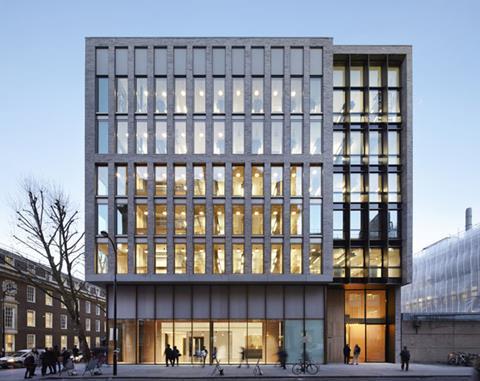By failing to carefully differentiate between accusations of genuine abuse and what may just be personal grievances, the Howlett Brown report has unfairly tarred all staff with the same brush and put academic independence in peril, writes Austin Williams

A number of academics, practitioners and commentators, myself included, recently signed a letter critical of the Howlett Brown report on the Bartlett School of Architecture (BSA). There have been a number of criticisms of its intent and hopefully this article can set the record straight.
The Howlett Brown consultancy spent six months or so trawling through 40 years – yes, 40 years - of testimony and has documented allegations of a “toxic learning and teaching culture” at the BSA. The Student Union is appalled and insists that “The safety of students from harm is the first responsibility of those leading and delivering education at UCL.” Is it? Surely the first duty is to educate.
While some of the alleged perpetrators are presumably long-dead, that doesn’t stop them being referenced. It is a very inclusive report in that way: everyone is anonymous so everyone is equally suspect.
Of course, if the most serious allegations of “sexist and racist remarks… anti-Semitism… physical violence… and inappropriate touching” are found to be true, the university has the right to dismiss faculty members for gross misconduct and a breach of trust, or whatever else is written into their contract. But before leaping to broader conclusions, consider the following.
Being named (via nudge, nudge, wink, wink clues) and shamed can be enough to destroy reputations
Thankfully, the report identifies very few specific cases of such behaviour. These serious allegations need to be proven before action – potentially justifiable action – is taken. We also need to ask whether these are examples of a toxic culture, or mercifully rare examples of egregious behaviour by a handful of individuals?
Secondly the accusers are anonymous and the staff members – as far as we are aware – have not been told of specific complaints against them. The distinction between an accusation, evidence, proof and guilt (which has tended to be a foundational process of natural justice and employment law) has been conflated. After all, the Howlett Brown report states; “the remit of our investigation was not to investigate and determine the merits of every allegation raised during our investigation.” But the inference of a widespread presumption of guilt is clear. Being named (via nudge, nudge, wink, wink clues) and shamed can be enough to destroy reputations, even if innocence is subsequently established.
Indeed, the report is actually an exercise in public shaming: calling out people (by hint rather than name) and with little regard for due process. I spoke to one staff member who wanted to leave for unrelated professional reasons but was now worried that it might be seen as an (untrue) admission of guilt. Another thought that they knew who was being described in the report and was therefore keeping their distance. Colleagues became suspects overnight.
The consequence of anonymised accusations, unsubstantiated grudges, decades old grievances, personal animosity, and professional resentment is not the right atmosphere to engender in any workplace, let alone within university departments that rely on creative tensions. Will there be pressure on the BSA to reject some of the names that have previously stood as a source of inspiration for the department on the grounds of unsubstantiated allegations alone?
Finally, there is a conflation of violent abusive relationships with the stressful rigour of an architectural crit. Five years ago, in an Architecture Foundation discussion on the value of architectural crits, Ellis Woodman quoted the distinguished Modernist, Isi Metzstein who “concluded one presentation at the University of Edinburgh with the words: ‘You’re crying? I’m the Head of School, I should be crying!’” Would this now be seen as an example of bullying, or of a compassionate professor trying to make a student smile?
And there’s the rub, anyone feeling hard done by, feeling insulted, has been given carte blanche to complain of harassment
The Howlett Brown report cites a former student complaining that their tutor had told them that they had “‘barely passed at the end of fourth year’ and that ‘[they] should quit and take a year out because [they] didn’t understand how buildings worked.’” This might be good advice for all we know, but in the Howlett Brown report it masquerades as abuse. And there’s the rub, anyone feeling hard done by, feeling insulted, has been given carte blanche to complain of harassment.
Of course, many won’t do that because students, staff and university departments are very collegiate places, people are generally nice, and relationships are respectful. Similarly, most crits are tense but enjoyable environments. But with one commentator seizing on the report to proclaim that cultures of abuse exist far more broadly than the Bartlett, toxicity will could well be assumed to be underlying everything.
In fact, the conflation of a harsh comment from a tutor in a crit, with grotesque racist taunts and physical abuse is one of the most insulting aspects of this report and of the response to it. Anyone who has had to endure racism and xenophobia, for example, will rightly be concerned that hatred, physical abuse and social ostracization is being likened to ill-judged comments about a student’s performance in a crit.
Aside from comparing architectural crits to abusive relationships, which is patently untrue, some seem to be revelling in discovering “toxicity” everywhere. “The findings of this report apply to so many architecture schools,” said one commentator. “Most of the behaviours described are things that can be found throughout architectural academia,” said another. Seeking out and discovering toxic relations will now become a priority: as if cleansing the Aegean stables. But what a low opinion of one’s fellow departmental staff members.
Postscript
Austin Williams is director of the Future Cities Project, and course leader, Kingston School of Art. He is writing in a personal capacity.
















8 Readers' comments